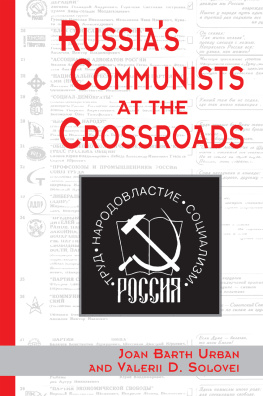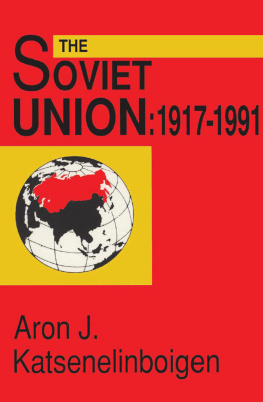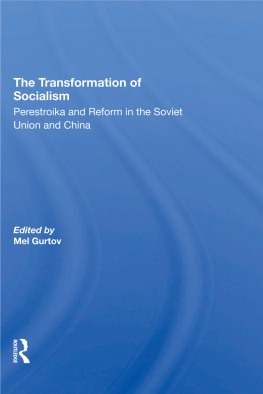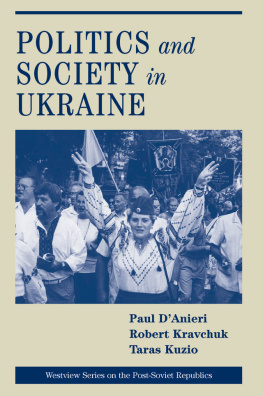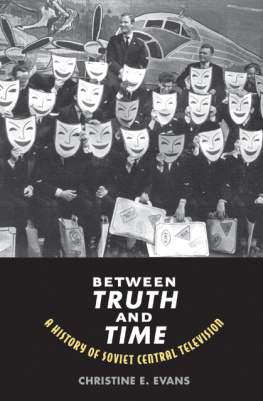THE SEPARATION OF THE PARTY AND THE STATE
To my family, especially my Parents and Vandita
The Separation of the Party and the State
Political Leadership in Soviet and Post-Soviet Phases
VINAYAK N. SRIVASTAVA
Institute for Social Sciences
New Delhi, India
First published 1999 by Ashgate Publishing
Reissued 2018 by Routledge
2 Park Square, Milton Park, Abingdon, Oxon, OX14 4RN
52 Vanderbilt Avenue, New York, NY 10017
Routledge is an imprint of the Taylor & Francis Group, an informa business
Copyright Vinayak N. Srivastava 1999
All rights reserved. No part of this book may be reprinted or reproduced or utilised in any form or by any electronic, mechanical, or other means, now known or hereafter invented, including photocopying and recording, or in any information storage or retrieval system, without permission in writing from the publishers.
Notice:
Product or corporate names may be trademarks or registered trademarks, and are used only for identification and explanation without intent to infringe.
Publishers Note
The publisher has gone to great lengths to ensure the quality of this reprint but points out that some imperfections in the original copies may be apparent.
Disclaimer
The publisher has made every effort to trace copyright holders and welcomes correspondence from those they have been unable to contact.
A Library of Congress record exists under LC control number:
ISBN 13: 978-1-138-36646-6 (hbk)
ISBN 13: 978-1-138-36647-3 (pbk)
ISBN 13: 978-0-429-43029-9 (ebk)
Contents
This book is the first full length study of one of the most important political institution of the erstwhile Soviet political system - the Central Committee of the Communist Party of the Soviet Union (CPSU). It discusses the reforms which the institution and the political leadership comprising it underwent during Perestroika. Tracing the historical background of the evolution of the Central Committee since its early days up to the begining of Perestroika, the book undertakes a comparitive analysis of the Central Committee at the threshold of Perestroika and the principles governing its constitution - composition, organisation and working, its transformations until the time it ceases to exist, the issues involved in the reforms and their bearing on this metamorphosis.
The originality of this work lies in its main argument that the central reform during Perestroika was that of the Party and the State - a reform which ultimately resulted in the CPSU and its institutions, the Central Committee being one of the most vital among them, firstly, surrendering the monopoly over political power and control over the instrumentalities of the State and secondly, systematically deinstitutionalising and dismantling the formidable Soviet political system. These eventually succumbed to the subalteran and subterranean forces hitherto lying dormant and their political manifestations such as the resurgent nationalisms and sub-nationalisms and a disintegrating economy coupled with a state of socio-cultural entropy. The political demise of the Soviet Union and birth of fifteen nation-states with distinctive political identities from the debris of the former is perhaps one of the greatest political transformations of the latter half of the twentieth century.
The seeds of transformation and the shape of politico-economic and socio-cultural systems that emerged in successor States were laid down during the Soviet era - in particular during Perestroika itself. The carrier of these transformations have been, in several cases, Soviet era political leadership which has continued to determine the destiny of these nascent nation-states. Many of them have been key members of the Central Committee itself, thus underlining the continuity with the Soviet past. Changes, however, too had been crystallising during the Soviet era, more distinctly during Perestroika under the impact of the competing forces of conservatism and reformism. Thus, although it was the separation of the Party and the State during Perestroika that culminated in the disintegration of the Soviet political system, the successor States and their politico-economic and socio-cultural systems are evolving within the paradigm laid during Perestroika with erstwhile political leadership playing the crucial role. The continuity, therefore, is as striking, if not more, as the change is.
The book is based on a wide range of Russian and translated primary and secondary sources, biographical directories and databases, memoirs of leading political actors, published documents and interviews held in Moscow with the members of the highest CPSU leadership organs, academicians and journalists.
I would like to acknowledge my appreciation to a number of institutions which assisted me during the course of my research. My gratitude goes to the Kings College and to the Faculty of Social and Political Sciences, University of Cambridge; to the Ministry of Human Resource Development, Government of India; and to the staff of the Cambridge University Library and Lenin Library, Moscow.
My gratitude goes to Professor John Barber and Professor David Lane. I owe special thanks to Professor Vera Pavlovna and Irena Bausova.
Institutions conduct the praxis of politics, state and governance. Individuals may be prominently situated in or above these institutions, they may sometimes seem to be the symbolic centre of power, yet, be they Kings or Prime Ministers, Presidents or General Secretaries, the institutions of the state and government are the real executor of the power and the governance. The institutionalised system with an institution or set of institutions evolve over a period of time to operationalise the dominant political ideology of a time and regime. This dominant political ideology, through a conscious or enlightened intervention or as an accepted value system which may be deemed to have existed since times immemorial and perceived as eternal, lays down the parameter, norms or paradigm governing a particular society in a specific time period. The institutions give a tangible shape and implement the perspective articulated by the dominant philosophy, generally imperfectly since the ideology defines the ideal type.
Social institutions influence the society, the economy, cultural and religious institutions, the spiritual aspect of the human life, as do the political institutions effect the political life of a country or a society. This is true for all kinds of political systems that have existed since human race learnt to govern itself and social- and political organisations evolved into complex systems. Institutions, a network of these, have sustained all hitherto known types of political systems-tribal, monarchical, authoritarian, autocratic, militaristic, liberal-democratic types, parliamentary or presidential, nationalistic, socialistic or communist. These could be simple or complex in terms of their forms and composition. Tribal institutions were obviously simpler in nature as were those of monarchical, authoritarian, autocratic and militaristic political systems. Thus the Soviet political system too was based on a set of institutions - some more important than others, and perhaps had the distinction of having been the most extensively studied one, with a very large number of scholarly characterisations defining its nature.
The political system was unique, as was the political philosophy on which it was founded and was an uniquely Twentieth century phenomenon based on an alternative and more egalitarian theory of modernisation in its ideal form, the other mainstream one being that of liberal-democracy.



